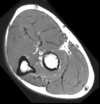Anatomy-Final Cram Sesh Flashcards
(72 cards)
What is indicated by the white arrow?

Vertebral prominens
Where are the breaks located in this bone?

Pars interarticularis
What is coming out of the vertebral body in this image?

Nucleus pulposus
What causes this?

This is winged scapula caused by loss of innervation to the serratus anterior (long thoracic nerve)
What comes from the paraxial mesoderm?
Somites. These then differentiate into skeletal muscle, cartilage, tendons, endothelia and skin.
Where does CSF reside?
Subarachnoid space
Where does 50% of cervical spine motion come from?
The atlanto-axial joint. The axis has the dens and the atlas sits on top of it, holding the dens in place with the transverse ligament

What provides blood supply to the ventral 2/3 of the spinal cord?
Anterior spinal arteries, to include the Great Anterior Segmental Medullary Artery of Adamkiewicz
What are all of these structures of the lateral neck?

Posterior scalene, Middle scalene, Phrenic nerve, Internal Jugular, Anterior Scalene, and Subclavian Artery/Vein

What are the different branches that come off the axillary artery?

1.) Superior thoracic 2.) Thoracoacromial, Lateral Thoracic 3.) Subscapular, Anterior and Posterior Circumflex Humeral

What muscles of the rotator cuff are seen here?

Supraspinatous, infraspinatous and teres minor

What muscles of the rotator cuff are seen here?

Supraspinatous, biceps long head tendon and infraspinatous

What are the different parts of the breast?

Lobule, fat, retromammary space and suspensory ligaments

How can you detect if the phrenic nerve was lacerated?
The paralyzed side will ascend on inspiration due to increased pressure from the gut as the non-paralyzed side descends on inspiration.

What are the branches of the brachial plexus?

*

What are the different components of the arm?

*

What is the pathway of lymph node drainage from the breast?

*

What is causing skin dimpling in this breast?

An aggressive breast tumor that has invaded the suspensory ligaments of Cooper

What is causing the signs seen in this breast?

Obstruction of lymphatics by advancer cancer cells.
What percent of breast cancers metastasize to the parasternal lymph nodes? What is the greatest risk factor for breast cancer?
5%. Age
What muscles attatch to the medial epicondyle of the humerus?
Pronator teres, flexor carpi radialis, palmaris longus, flexor carpi ulnaris

What is the pathway of the radial artery through the forearm and into the hand? The ulnar?
*

What goes around Lister’s tubercle?
Extensor pollicus longus
Where does the anterior interosseous nerve branch from? Posterior interosseous nerve?
Median. Radial


























